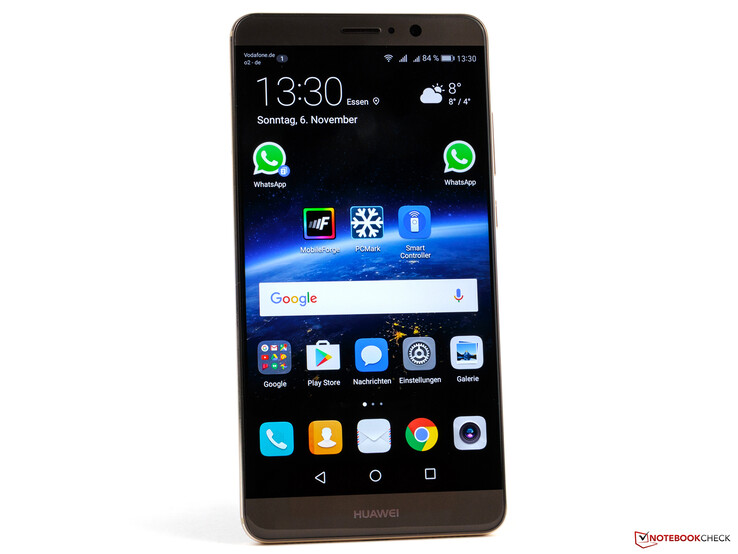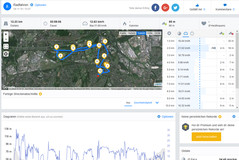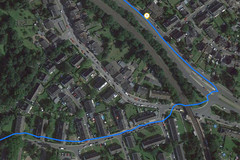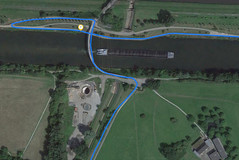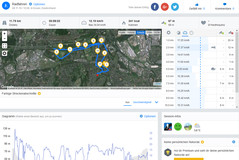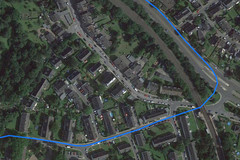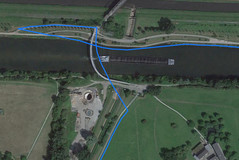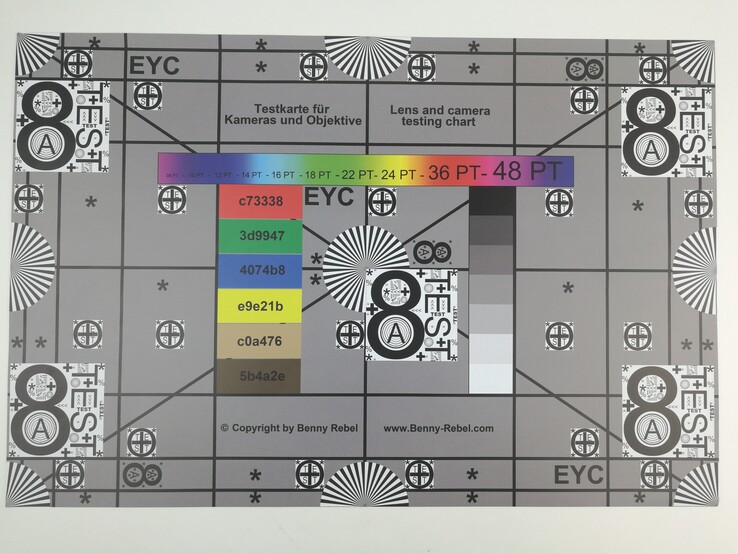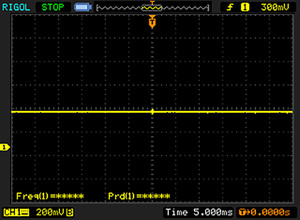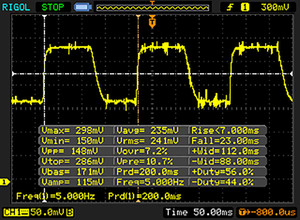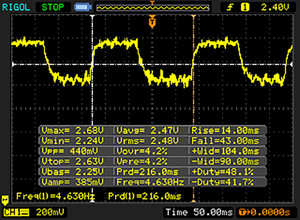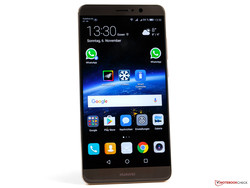华为 Mate 9 大屏智能手机简短评测
» Notebookcheck多媒体笔记本电脑Top 10排名
» Notebookcheck游戏笔记本电脑Top 10排名
» Notebookcheck低价办公/商务笔记本电脑Top 10排名
» Notebookcheck高端办公/商务笔记本电脑Top 10排名
» Notebookcheck工作站笔记本电脑Top 10排名
» Notebookcheck亚笔记本电脑Top 10排名
» Notebookcheck超级本产品Top 10排名
» Notebookcheck变形本产品Top 10排名
» Notebookcheck平板电脑Top 10排名
» Notebookcheck智能手机Top 10排名
» Notebookcheck评测过最出色的笔记本电脑屏幕
» Notebookcheck售价500欧元以下笔记本电脑Top 10排名
» Notebookcheck售价300欧元以下笔记本电脑Top 10排名
| Networking | |
| iperf3 transmit AX12 | |
| Apple iPhone 7 (Klaus I211) | |
| Google Pixel XL 2016 | |
| Samsung Galaxy S7 Edge | |
| LG G5 | |
| Huawei Mate 9 | |
| iperf3 receive AX12 | |
| Apple iPhone 7 (Klaus I211) | |
| Google Pixel XL 2016 | |
| Samsung Galaxy S7 Edge | |
| Huawei Mate 9 | |
| LG G5 | |
| |||||||||||||||||||||||||
Brightness Distribution: 93 %
Center on Battery: 696 cd/m²
Contrast: 1657:1 (Black: 0.42 cd/m²)
ΔE ColorChecker Calman: 4.3 | ∀{0.5-29.43 Ø4.78}
ΔE Greyscale Calman: 4.8 | ∀{0.09-98 Ø5}
Gamma: 2.33
CCT: 7255 K
| Huawei Mate 9 IPS, 1920x1080, 5.9" | Huawei Mate 8 IPS-NEO, 1920x1080, 6" | Apple iPhone 7 Plus IPS, 1920x1080, 5.5" | Google Pixel XL 2016 AMOLED, 2560x1440, 5.5" | LG G5 IPS Quantum, 2560x1440, 5.3" | Samsung Galaxy Note 5 SM-N920A Super AMOLED, 2560x1440, 5.7" | Microsoft Lumia 950 XL AMOLED, 2560x1440, 5.7" | |
|---|---|---|---|---|---|---|---|
| Screen | -8% | 23% | -10% | -14% | 7% | 4% | |
| Brightness middle (cd/m²) | 696 | 514 -26% | 557 -20% | 402 -42% | 784 13% | 394.8 -43% | 297 -57% |
| Brightness (cd/m²) | 680 | 513 -25% | 553 -19% | 408 -40% | 774 14% | 397 -42% | 297 -56% |
| Brightness Distribution (%) | 93 | 94 1% | 97 4% | 85 -9% | 91 -2% | 91 -2% | 93 0% |
| Black Level * (cd/m²) | 0.42 | 0.35 17% | 0.35 17% | 0.43 -2% | |||
| Contrast (:1) | 1657 | 1469 -11% | 1591 -4% | 1823 10% | |||
| Colorchecker dE 2000 * | 4.3 | 5.08 -18% | 1.4 67% | 4 7% | 6.5 -51% | 1.49 65% | 2.67 38% |
| Colorchecker dE 2000 max. * | 9.4 | 8.28 12% | 3.1 67% | 10.1 -7% | 11.7 -24% | 3.98 58% | |
| Greyscale dE 2000 * | 4.8 | 5.49 -14% | 1.3 73% | 3.2 33% | 8 -67% | 1.98 59% | 2.81 41% |
| Gamma | 2.33 94% | 2.08 106% | 2.21 100% | 2.19 100% | 2.22 99% | 2.19 100% | 2.08 106% |
| CCT | 7255 90% | 7254 90% | 6667 97% | 7037 92% | 8699 75% | 6382 102% | 6379 102% |
| Color Space (Percent of AdobeRGB 1998) (%) | 79.95 | 63.1 | 68.08 | 66.31 | |||
| Color Space (Percent of sRGB) (%) | 99.84 | 99.83 | 97.46 | 99.79 |
* ... smaller is better
Screen Flickering / PWM (Pulse-Width Modulation)
| Screen flickering / PWM not detected | |||
In comparison: 53 % of all tested devices do not use PWM to dim the display. If PWM was detected, an average of 8111 (minimum: 5 - maximum: 343500) Hz was measured. | |||
Display Response Times
| ↔ Response Time Black to White | ||
|---|---|---|
| 30 ms ... rise ↗ and fall ↘ combined | ↗ 7 ms rise | |
| ↘ 23 ms fall | ||
| The screen shows slow response rates in our tests and will be unsatisfactory for gamers. In comparison, all tested devices range from 0.1 (minimum) to 240 (maximum) ms. » 79 % of all devices are better. This means that the measured response time is worse than the average of all tested devices (20.2 ms). | ||
| ↔ Response Time 50% Grey to 80% Grey | ||
| 57 ms ... rise ↗ and fall ↘ combined | ↗ 14 ms rise | |
| ↘ 43 ms fall | ||
| The screen shows slow response rates in our tests and will be unsatisfactory for gamers. In comparison, all tested devices range from 0.165 (minimum) to 636 (maximum) ms. » 94 % of all devices are better. This means that the measured response time is worse than the average of all tested devices (31.6 ms). | ||
| AnTuTu v6 - Total Score (sort by value) | |
| Huawei Mate 9 | |
| Huawei Mate 8 | |
| Microsoft Lumia 950 XL | |
| Apple iPhone 7 Plus | |
| Google Pixel XL 2016 | |
| Samsung Galaxy S7 Edge | |
| Lenovo Moto Z | |
| Huawei P9 | |
| Geekbench 4.0 | |
| 64 Bit Single-Core Score (sort by value) | |
| Huawei Mate 9 | |
| Apple iPhone 7 Plus | |
| Google Pixel XL 2016 | |
| Samsung Galaxy S7 Edge | |
| Lenovo Moto Z | |
| Huawei P9 | |
| 64 Bit Multi-Core Score (sort by value) | |
| Huawei Mate 9 | |
| Apple iPhone 7 Plus | |
| Google Pixel XL 2016 | |
| Samsung Galaxy S7 Edge | |
| Lenovo Moto Z | |
| Huawei P9 | |
| GFXBench (DX / GLBenchmark) 2.7 | |
| T-Rex Onscreen (sort by value) | |
| Huawei Mate 9 | |
| Huawei Mate 8 | |
| Microsoft Lumia 950 XL | |
| Apple iPhone 7 Plus | |
| Google Pixel XL 2016 | |
| Samsung Galaxy S7 Edge | |
| Lenovo Moto Z | |
| Huawei P9 | |
| 1920x1080 T-Rex Offscreen (sort by value) | |
| Huawei Mate 9 | |
| Huawei Mate 8 | |
| Microsoft Lumia 950 XL | |
| Apple iPhone 7 Plus | |
| Google Pixel XL 2016 | |
| Samsung Galaxy S7 Edge | |
| Lenovo Moto Z | |
| Huawei P9 | |
| GFXBench 3.1 | |
| on screen Manhattan ES 3.1 Onscreen (sort by value) | |
| Huawei Mate 9 | |
| Huawei Mate 8 | |
| Apple iPhone 7 Plus | |
| Google Pixel XL 2016 | |
| Samsung Galaxy S7 Edge | |
| Lenovo Moto Z | |
| Huawei P9 | |
| 1920x1080 Manhattan ES 3.1 Offscreen (sort by value) | |
| Huawei Mate 9 | |
| Huawei Mate 8 | |
| Apple iPhone 7 Plus | |
| Google Pixel XL 2016 | |
| Samsung Galaxy S7 Edge | |
| Lenovo Moto Z | |
| Huawei P9 | |
| PCMark for Android - Work performance score (sort by value) | |
| Huawei Mate 9 | |
| Huawei Mate 8 | |
| Samsung Galaxy Note 5 SM-N920A | |
| Google Pixel XL 2016 | |
| Samsung Galaxy S7 Edge | |
| Lenovo Moto Z | |
| Huawei P9 | |
| Basemark ES 3.1 / Metal - offscreen Overall Score (sort by value) | |
| Huawei Mate 9 | |
| Huawei Mate 8 | |
| Apple iPhone 7 Plus | |
| Google Pixel XL 2016 | |
| Samsung Galaxy S7 Edge | |
| Lenovo Moto Z | |
| Huawei P9 | |
| Lightmark - 1920x1080 1080p (sort by value) | |
| Huawei Mate 9 | |
| Huawei Mate 8 | |
| Samsung Galaxy Note 5 SM-N920A | |
| Samsung Galaxy S7 Edge | |
| Lenovo Moto Z | |
| Huawei P9 | |
| BaseMark OS II - Web (sort by value) | |
| Huawei Mate 9 | |
| Huawei Mate 8 | |
| Samsung Galaxy Note 5 SM-N920A | |
| Microsoft Lumia 950 XL | |
| Apple iPhone 7 Plus | |
| Google Pixel XL 2016 | |
| Samsung Galaxy S7 Edge | |
| Lenovo Moto Z | |
| Huawei P9 | |
| Vellamo 3.x - Browser (sort by value) | |
| Huawei Mate 9 | |
| Huawei Mate 8 | |
| Samsung Galaxy Note 5 SM-N920A | |
| Google Pixel XL 2016 | |
| Samsung Galaxy S7 Edge | |
| Lenovo Moto Z | |
| Huawei P9 | |
* ... smaller is better
| Huawei Mate 9 Mali-G71 MP8, Kirin 960, 64 GB UFS 2.1 Flash | Huawei Mate 8 Mali-T880 MP4, Kirin 950, 32 GB eMMC Flash | Samsung Galaxy Note 5 SM-N920A Mali-T760 MP8, Exynos 7420, 32 GB UFS 2.0 Flash | Google Pixel XL 2016 Adreno 530, SD 821, 32 GB eMMC Flash | Samsung Galaxy S7 Edge Mali-T880 MP12, Exynos 8890, 32 GB UFS 2.0 Flash | Lenovo Moto Z Adreno 530, 820 MSM8996, 32 GB eMMC Flash | Huawei P9 Mali-T880 MP4, Kirin 955, 32 GB eMMC Flash | |
|---|---|---|---|---|---|---|---|
| AndroBench 3-5 | -17% | 25% | -10% | 28% | 145% | 44% | |
| Sequential Read 256KB (MB/s) | 594 | 238.3 -60% | 385.4 -35% | 258.2 -57% | 487.3 -18% | 439.7 -26% | 281.3 -53% |
| Sequential Write 256KB (MB/s) | 142.9 | 124.8 -13% | 150.1 5% | 83.4 -42% | 145.1 2% | 168.3 18% | 72.2 -49% |
| Random Read 4KB (MB/s) | 94.7 | 24.98 -74% | 90.3 -5% | 87.7 -7% | 86.7 -8% | 117.2 24% | 39 -59% |
| Random Write 4KB (MB/s) | 8.77 | 15.74 79% | 20.42 133% | 14.56 66% | 15.79 80% | 74.9 754% | 47.45 441% |
| Sequential Read 256KB SDCard (MB/s) | 54 | 76.4 41% | 78.5 45% | 55 2% | |||
| Sequential Write 256KB SDCard (MB/s) | 29.53 | 50.4 71% | 45.64 55% | 24.83 -16% |
| Asphalt 8: Airborne | |||
| Settings | Value | ||
| high | 30 fps | ||
| very low | 30 fps | ||
| Dead Trigger 2 | |||
| Settings | Value | ||
| high | 60 fps | ||
(±) The maximum temperature on the upper side is 44.4 °C / 112 F, compared to the average of 35.2 °C / 95 F, ranging from 21.9 to 247 °C for the class Smartphone.
(±) The bottom heats up to a maximum of 41.6 °C / 107 F, compared to the average of 34 °C / 93 F
(+) In idle usage, the average temperature for the upper side is 30.8 °C / 87 F, compared to the device average of 32.9 °C / 91 F.
Huawei Mate 9 audio analysis
(+) | speakers can play relatively loud (83.9 dB)
Bass 100 - 315 Hz
(-) | nearly no bass - on average 24.1% lower than median
(±) | linearity of bass is average (11.1% delta to prev. frequency)
Mids 400 - 2000 Hz
(+) | balanced mids - only 3.2% away from median
(±) | linearity of mids is average (8.6% delta to prev. frequency)
Highs 2 - 16 kHz
(±) | higher highs - on average 10.4% higher than median
(+) | highs are linear (3.8% delta to prev. frequency)
Overall 100 - 16.000 Hz
(±) | linearity of overall sound is average (25.2% difference to median)
Compared to same class
» 62% of all tested devices in this class were better, 7% similar, 32% worse
» The best had a delta of 11%, average was 35%, worst was 134%
Compared to all devices tested
» 76% of all tested devices were better, 5% similar, 19% worse
» The best had a delta of 4%, average was 24%, worst was 134%
Google Pixel XL 2016 audio analysis
(+) | speakers can play relatively loud (88.5 dB)
Bass 100 - 315 Hz
(-) | nearly no bass - on average 21.8% lower than median
(±) | linearity of bass is average (11.2% delta to prev. frequency)
Mids 400 - 2000 Hz
(+) | balanced mids - only 3.5% away from median
(+) | mids are linear (4.3% delta to prev. frequency)
Highs 2 - 16 kHz
(±) | higher highs - on average 8.1% higher than median
(+) | highs are linear (4.2% delta to prev. frequency)
Overall 100 - 16.000 Hz
(±) | linearity of overall sound is average (20.4% difference to median)
Compared to same class
» 34% of all tested devices in this class were better, 9% similar, 57% worse
» The best had a delta of 11%, average was 35%, worst was 134%
Compared to all devices tested
» 53% of all tested devices were better, 8% similar, 39% worse
» The best had a delta of 4%, average was 24%, worst was 134%
Apple iPhone 7 Plus audio analysis
(±) | speaker loudness is average but good (81.4 dB)
Bass 100 - 315 Hz
(-) | nearly no bass - on average 24.1% lower than median
(±) | linearity of bass is average (7.4% delta to prev. frequency)
Mids 400 - 2000 Hz
(+) | balanced mids - only 4.7% away from median
(±) | linearity of mids is average (7.6% delta to prev. frequency)
Highs 2 - 16 kHz
(+) | balanced highs - only 4.3% away from median
(+) | highs are linear (6.9% delta to prev. frequency)
Overall 100 - 16.000 Hz
(±) | linearity of overall sound is average (22% difference to median)
Compared to same class
» 45% of all tested devices in this class were better, 7% similar, 48% worse
» The best had a delta of 11%, average was 35%, worst was 134%
Compared to all devices tested
» 63% of all tested devices were better, 7% similar, 31% worse
» The best had a delta of 4%, average was 24%, worst was 134%
| Off / Standby | |
| Idle | |
| Load |
|
Key:
min: | |
| Huawei Mate 9 4000 mAh | Huawei Mate 8 4000 mAh | Microsoft Lumia 950 XL 3340 mAh | Samsung Galaxy S7 Edge 3600 mAh | Google Pixel XL 2016 3450 mAh | Lenovo Moto Z 2600 mAh | LG G5 2800 mAh | |
|---|---|---|---|---|---|---|---|
| Power Consumption | 11% | -88% | 20% | 29% | 25% | 4% | |
| Idle Minimum * (Watt) | 0.78 | 0.85 -9% | 2.85 -265% | 0.63 19% | 0.53 32% | 0.66 15% | 0.55 29% |
| Idle Average * (Watt) | 2.13 | 2.07 3% | 2.95 -38% | 1.1 48% | 1.07 50% | 1.01 53% | 1.37 36% |
| Idle Maximum * (Watt) | 2.17 | 2.28 -5% | 3.26 -50% | 1.56 28% | 1.12 48% | 1.09 50% | 2.25 -4% |
| Load Average * (Watt) | 6.32 | 3.91 38% | 8.92 -41% | 5.95 6% | 5.53 12% | 3.97 37% | 6.24 1% |
| Load Maximum * (Watt) | 6.49 | 4.69 28% | 9.39 -45% | 6.7 -3% | 6.26 4% | 8.34 -29% | 9.12 -41% |
* ... smaller is better
| Huawei Mate 9 4000 mAh | Huawei Mate 8 4000 mAh | Apple iPhone 7 Plus 2915 mAh | Microsoft Lumia 950 XL 3340 mAh | Google Pixel XL 2016 3450 mAh | Samsung Galaxy Note 5 SM-N920A mAh | |
|---|---|---|---|---|---|---|
| Battery runtime | 14% | -3% | -34% | -23% | 6% | |
| Reader / Idle (h) | 25.6 | 31.2 22% | 30.6 20% | 18 -30% | 22.2 -13% | 29.6 16% |
| H.264 (h) | 15.8 | 16.1 2% | 13.6 -14% | 10.2 -35% | 8.4 -47% | |
| WiFi v1.3 (h) | 12.6 | 14.4 14% | 9.8 -22% | 6.2 -51% | 8.4 -33% | 7.2 -43% |
| Load (h) | 3.7 | 4.3 16% | 3.8 3% | 3 -19% | 3.8 3% | 5.4 46% |
Pros
Cons
华为Mate 9是这个高端大屏手机系列的一个新成员。它在功能性和性能上更进一步,尽管屏幕尺寸略有缩小,仍然保持了同类设备中最大的尺寸。尽管机身相对较大,但握持手感仍然十分优秀。
它的技术参数非常出色。麒麟960是一块速度很快的高端芯片组,市场上最快处理器的之一。我们十分喜欢它的多任务处理功能。你还会得到4GB内存和64GB闪存(UFS 2.1)空间,它们的性能也都十分优秀。它可以通过microSD卡槽扩展,不过华为应该改进这个读卡器的速度,它的表现只能算是一般般。考虑到5.9寸的大尺寸,它的屏幕分辨率也还有提高的空间。
华为Mate 9搭配了强劲的硬件,并提供了很好的耐力。如果你喜欢大屏手机的话,那么Mate 9是个非常明智的选择。
Mate 9在连接性上无懈可击。它支持高速LTE Cat.11,覆盖多个频段意味着它可以在世界上的大部分地区使用。归功于应用克隆功能,它的双SIM卡机型甚至可以同时使用两个WhatsApp账户(或微信)。它的无线网络连接距离很远,只是传输速率低于其他高端设备。
大容量电池保证了长时间的电池续航,让它更加全面。因此如果你在寻找一台高端配置的大屏幕手机的话,华为Mate 9在市场上罕逢敌手。
注:本文是基于完整评测的缩减版本,阅读完整的英文评测,请点击这里。
Huawei Mate 9
- 11/08/2016 v5.1 (old)
Daniel Schmidt




